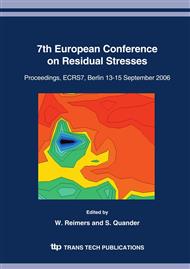p.205
p.211
p.217
p.223
p.229
p.235
p.241
p.247
p.253
Review of Residual Stress Determination and Exploitation Techniques Using X-Ray Diffraction Method
Abstract:
Although x-ray diffraction techniques have been applied to the measurement of residual stress in the industry for decades, some of the related details are still unclear to many production and mechanical testing engineers working in the field. This is because these details, specifically those associated with the transition between diffraction and mechanics, are not always emphasized in the literature. This paper will emphasize the appropriate calculation methods and the steps necessary to perform high quality residual stress measurements. Additionally, details are given regarding the difference between mechanical and x-ray elastic constants, as well as the true meaning of stress and strain from both diffraction and strain gage point of view. Cases where the material is subject to loading above the yield limit are also included.
Info:
Periodical:
Pages:
229-234
Citation:
Online since:
September 2006
Authors:
Keywords:
Price:
Сopyright:
© 2006 Trans Tech Publications Ltd. All Rights Reserved
Share:
Citation:


